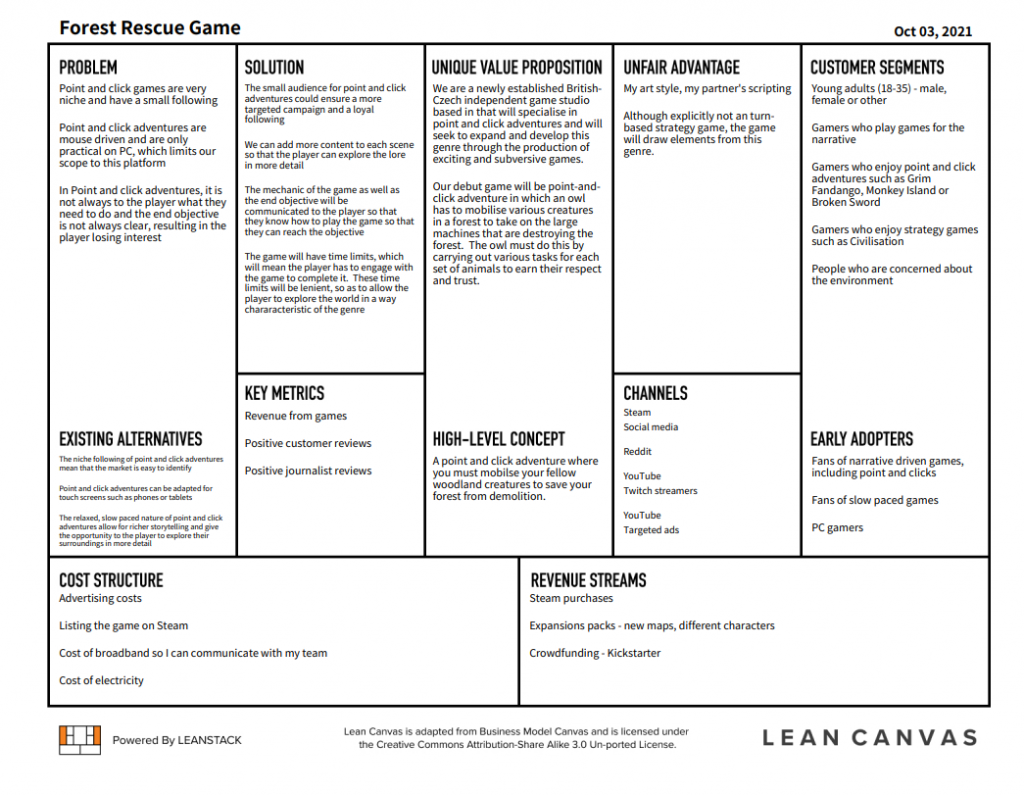For this week’s assignment, we needed to create a Lean Canvas to identify how viable it will be to create our game in a way that is marketable and taps into unmet market needs.
This is the lean canvas that I have come up with for our point-and-click adventure game

You can view this in full by clicking here.
As you can see, I have explored the limitations the point-and-click adventure and how I can ensure that our game addresses these. I have also listed the advantages and how we can exploit these and develop them further to make our own game appealing.
Our game is explicitly going to be a point and click adventure and not a strategy, but we intend to draw inspiration from turn based and real time strategy games for some of the mechanics. This will allow us to appeal to fans of both point and click adventures and strategy games.
Point and click adventures tend to be slow paced and relaxing in nature as they allow richer story telling and for the player to explore the world at their own pace. However, point and click adventures can sometimes lack a clear end objective or is not clearly communicated to the player. With our game, we intend to amend this by making our game so that the mechanics are communicated clearly to the player in a way that allows them to play the game and reach the objective.
The game will also have various time limits, which mean that the player will need to carry out actions in the game within a certain amount of time, meaning they need to engage with it. However, these time limits will be lenient, in order to allow the player to explore the world in a way characteristic of the point-and-click genre.
I have presented the above lean canvas as being for a British-Czech indie game studio that specialises in point-and-click adventures and seeks to expand the genre through the production of challenging and subversive games.
We have also considered channels that we will promote the game on, such as social media, Twitch, the Steam store and targeted ads.
Our main costs would be advertising, listing the game on Steam, cost of broadband to communicate with my teammate and also the cost of electricity. We will generate revenue from crowdfunding on Kickstarter, as well as Steam purchases.
I will likely use this in our business plan for our game to show that we have considered how we are going to market this game and appeal to our target audiences.
I used the following references in the creation of this Lean Canvas:
GDC, 2018
Invert-x.com. 2021
Lobb, I., n.d.
The Point & Click Devlog, 2021.
References
GDC, 2018. Let’s Be Realistic: A Deep Dive into How Games Are Selling on Steam. Available at: <https://www.youtube.com/watch?v=WycVOCbeKqQ> [Accessed 3 October 2021].
GDC, 2018. Know Your Market: Making Indie Games That Sell . Available at: <https://www.youtube.com/watch?v=uy0Dfr-mnUY> [Accessed 3 October 2021].
Invert-x.com. 2021. Invert-x | Point and click adventures. [online] Available at: <https://invert-x.com/2012/04/point-and-click-adventures/> [Accessed 3 October 2021].
Lobb, I., n.d. Creating a Viable Product.
The Point & Click Devlog, 2021. What makes point and click adventure games good? – YouTube. [image] Available at: <https://www.youtube.com/watch?v=XUso3zWbDfE> [Accessed 3 October 2021].